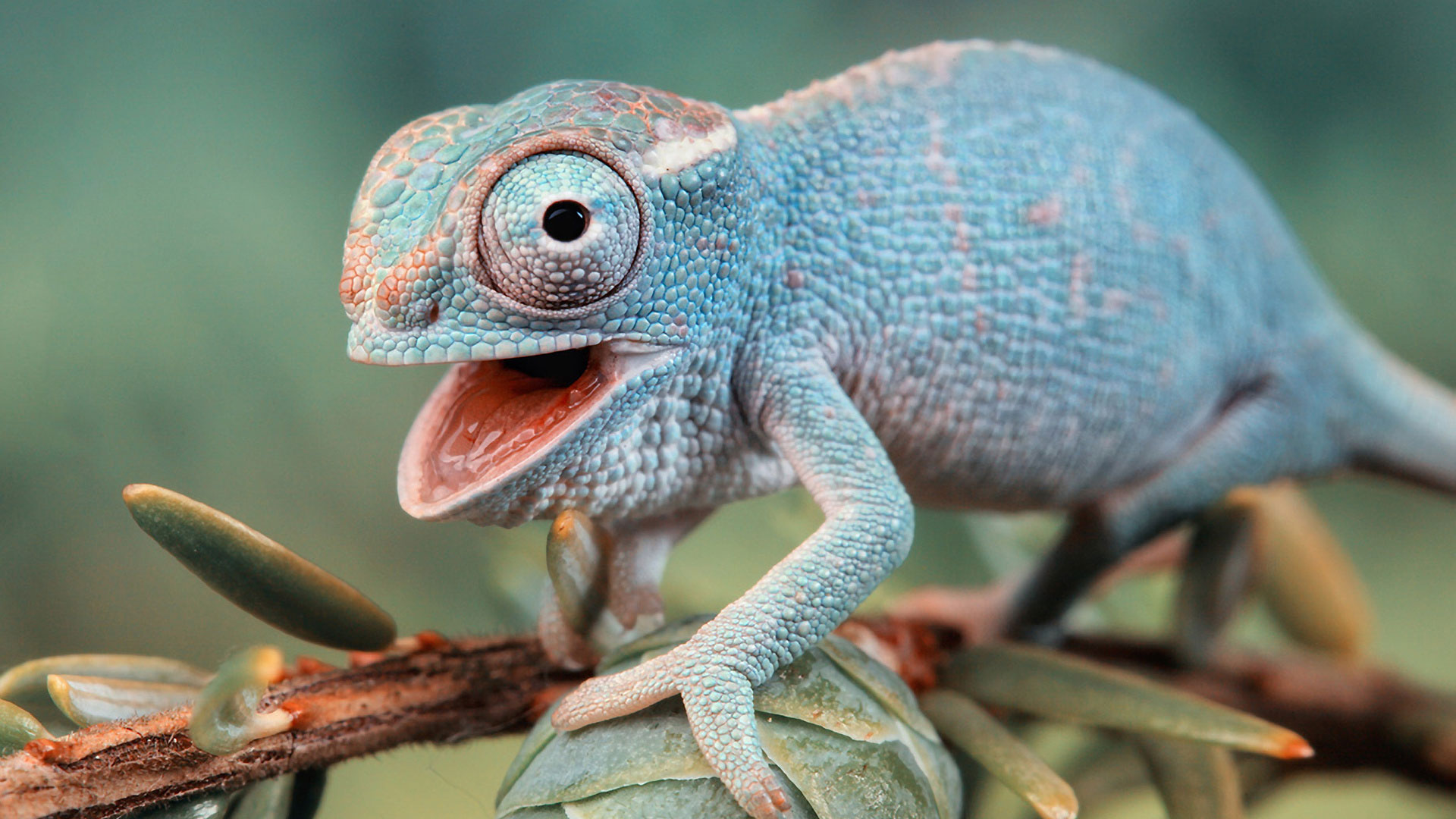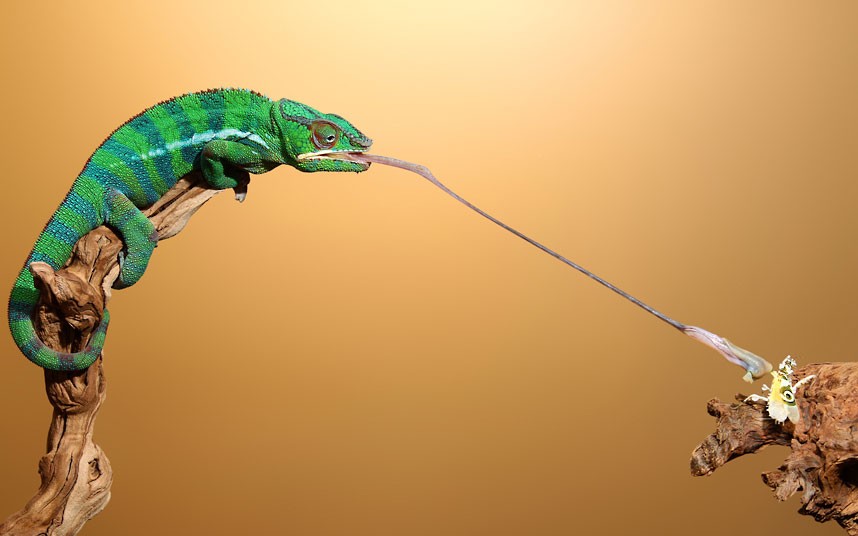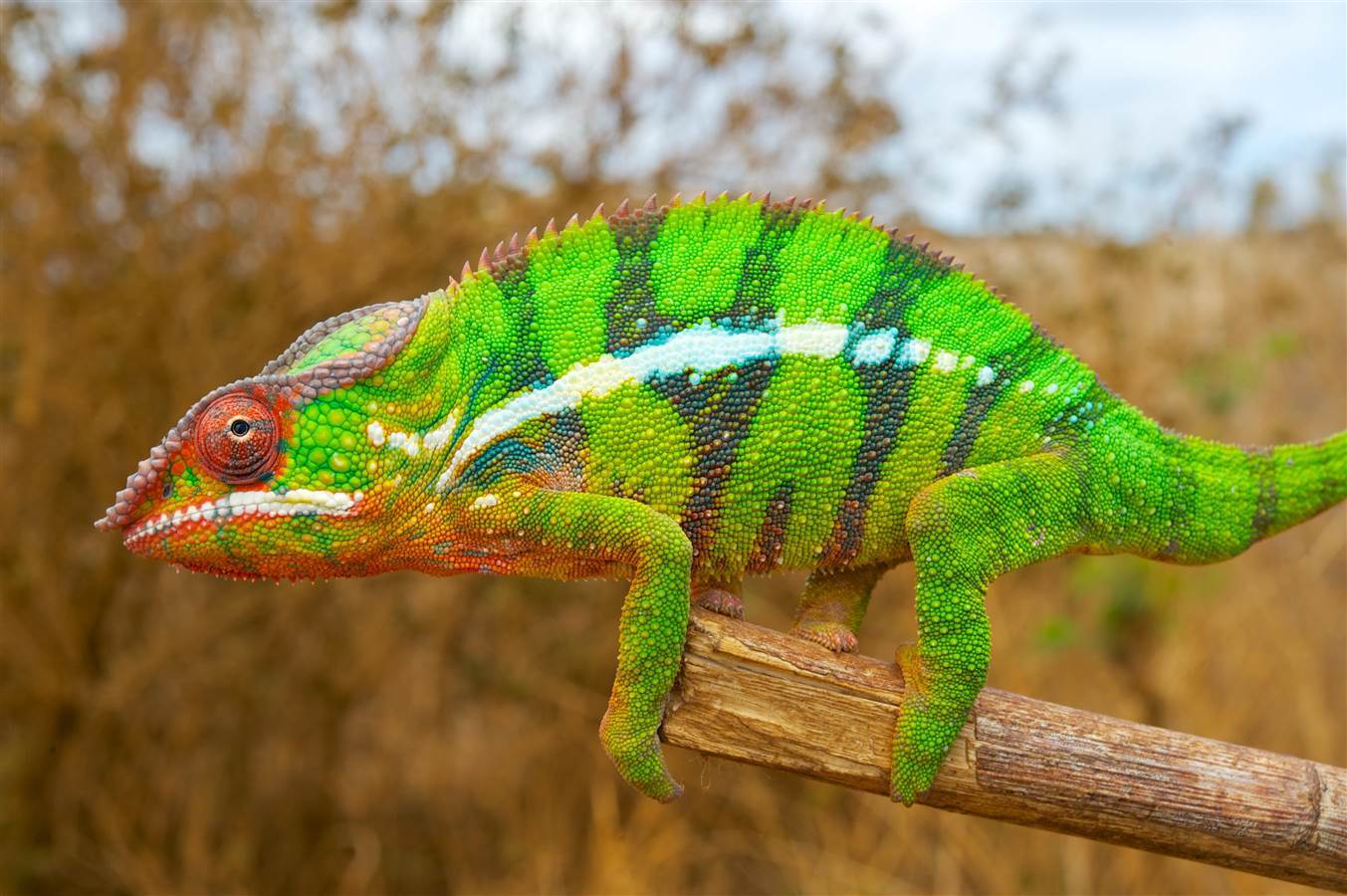Perfect silent killer - chameleon
Scientists were only now able to explain the capture of these animals.

Do you see this photo of a talented hunter? Not? And he is.
Chameleons are amazing creatures. Their vision, structure of the skin, the principle of hunting - all this is unique. The chameleon looks a bit strange, even funny. But it is for man. And in nature, a chameleon is a dangerous killer, quiet and precise. True, the chameleon hunts only for relatively small insects, which he is able to swallow. As soon as the chameleon sees the prey, it throws out a long and very sticky tongue at the end (let's talk about the reason for this stickiness below). The tongue of a chameleon is one of the most developed organs of the body. We can say that this is his sixth limb (if we consider his tenacious tail fifth). With the help of tongue, a chameleon is able to capture and swallow prey to a third of the weight of an animal. And all this - without the slightest body movement, only language works.
')
How exactly the chameleon captures the victim has remained a mystery for many years. It was even difficult to understand how an animal throws its tongue at such a speed at such distances (two body lengths in a split second). And how the capture of the victim and the return to the mouth of the chameleon is an even more difficult question. As it turned out, the reason for the success of a quiet hunt is the stickiness of the chameleon's tongue. It is not just sticky, but extremely sticky.
This property of the tongue is due to the viscosity of the chameleon saliva . It is 400 times more viscous than human saliva. Under certain conditions, this substance behaves like an elastic solid, and not like a liquid. This is the key to understanding the "language capture" mechanism.
Saliva is produced in very small amounts by special glands of the tongue. Scientists managed to measure the viscosity of this fluid, despite all the difficulties. With the help of the bait, the chameleon managed to get the tongue out, hitting the microscope slide. Saliva stamped on the glass. After that, the second phase of the experiment immediately began - viscosity measurement. Scientists have used the second glass, with the applied control liquid, the viscosity of which is known. After that, tiny metal balls began to roll along the first and second liquids. The glass was tilted at a certain angle. The maximum angle of inclination at which the ball did not roll, but remained in the test liquid, made it possible to measure the viscosity of this liquid.
“The unexpectedly high saliva viscosity suggests that victims stick to the chameleon language due to viscous adhesion,” says study leader Pascal Damman. “But even the knowledge of this quantity is not enough to determine the strength of viscous adhesion. To measure the strength of adhesion, we used a dynamic model of the retraction phase. ”
Scientists managed to find out that when an insect hits a tongue, the tongue expands and the area of contact with the prey increases. This means that the insect's adhesion to the surface of the tongue significantly increases. Despite the fact that the tongue quickly comes back, the force of adhesion is sufficient so that the victim does not “fall through”. “Viscous adhesion is an effective way of holding even a very large sacrifice,” says the scientist. Viscous fluid is produced only during the ejection of the tongue.
Measuring the viscosity of chameleon saliva allowed us to confirm one of the assumptions about how the chameleon keeps the prey at the tip of the tongue. Back in the 50s of the last century, the “theory of sticking” was created, according to which the victim simply sticks to some adhesive substance on the tip of the chameleon tongue. After this, the assumption was rejected as untenable, believing that once a chameleon can throw out an inedible object from the mouth, it means saliva has nothing to do with it. Confirmation came from scientists who conducted an experiment with the blocking of animal nerves responsible for the work of the tongue. After blocking the nerve canals controlling the tip of the tongue, the chameleons were unable to capture the victims. Yes, the tongue was thrown away, but the prey did not stick to it.
Now it turned out that the scientists who wrote about the chameleon in the 50s are right. Another interesting point. Chameleons can release large victims without any problems (if the prey is very strong) due to the fact that the language takes a certain shape, like a bowl, when discarded. She was called the “suction cup”. Small insects are immediately in the "bowl" in the capture. But large prey is only partially covered by the tongue.
The tongue is ejected while the two muscles are working on both sides of the chameleon's hyoid bone. He returns in the form of a spiral scroll.
This year, biologists at the American Brown University decided to determine how fast chameleons are as hunters. They selected 20 types of chameleons and began to capture the prey captured by a representative of each type with a high-speed camera (up to 3000 frames per second). As it turned out, on average, the process of ejection of the language takes only 1/20 of a second. The return of the language to its original position with the victim takes about half a second. For three seconds, the chameleon can identify and catch up to 4 insects. If the chameleon does not hunt, the tongue is held by a special bone of the lower jaw.

With regard to the effectiveness of hunting of various species, the most deadly hunters were chameleons of the species Rhampholeon spinosus. Their body size is only 4 centimeters, but the tongue is thrown to a length 2.5 times the length of the animal. Language at the same time gaining speed of 100 km / h in just a hundredth of a second.
Brookesia superciliaris, Rieppeleon brevicaudatus and Trioceros hoehnelii are slightly less effective hunters. They have a language twice as long as their body. And the least deadly for the victim is the giant chameleon Furcifer oustaleti, growing to a size of 60 centimeters or more.
According to experts, the accuracy of throwing the language of small species of chameleons is explained by high energy consumption. If the little chameleon misses, he will have to gain strength for the next attack. But the big chameleon has enough energy to re-throw.
Of course, change the color and pattern of the body. This makes the animal even more deadly for its victims. The ability to change color is associated with the structure of the chameleon skin. A large number of chromatophore cells are located in the outer layer of the skin. These cells contain grains of pigments of various colors, including black, dark brown, reddish and yellow. The combination of these colors allows the chameleon to paint their skin in many different shades.

In addition to chromatophores, chameleons also have special cells with crystals inside which can reflect and refract light. And in the deepest subcutaneous layer of the chameleon, scientists have discovered crystals that help the animal to reflect infrared radiation. Thanks to these cells, the chameleon can reflect infrared radiation, maintaining body temperature in the heat.
The animal can quickly change the color of the body from black to whitish. This may change the color is not all of the skin, but some of its parts.
Color changes under the influence of various factors, including the external environment and the state of the animal's body. Some types of chameleons change the color of the skin, not to hide, but to communicate with representatives of their own species.

Do you see this photo of a talented hunter? Not? And he is.
Chameleons are amazing creatures. Their vision, structure of the skin, the principle of hunting - all this is unique. The chameleon looks a bit strange, even funny. But it is for man. And in nature, a chameleon is a dangerous killer, quiet and precise. True, the chameleon hunts only for relatively small insects, which he is able to swallow. As soon as the chameleon sees the prey, it throws out a long and very sticky tongue at the end (let's talk about the reason for this stickiness below). The tongue of a chameleon is one of the most developed organs of the body. We can say that this is his sixth limb (if we consider his tenacious tail fifth). With the help of tongue, a chameleon is able to capture and swallow prey to a third of the weight of an animal. And all this - without the slightest body movement, only language works.
')
How exactly the chameleon captures the victim has remained a mystery for many years. It was even difficult to understand how an animal throws its tongue at such a speed at such distances (two body lengths in a split second). And how the capture of the victim and the return to the mouth of the chameleon is an even more difficult question. As it turned out, the reason for the success of a quiet hunt is the stickiness of the chameleon's tongue. It is not just sticky, but extremely sticky.
This property of the tongue is due to the viscosity of the chameleon saliva . It is 400 times more viscous than human saliva. Under certain conditions, this substance behaves like an elastic solid, and not like a liquid. This is the key to understanding the "language capture" mechanism.
Saliva is produced in very small amounts by special glands of the tongue. Scientists managed to measure the viscosity of this fluid, despite all the difficulties. With the help of the bait, the chameleon managed to get the tongue out, hitting the microscope slide. Saliva stamped on the glass. After that, the second phase of the experiment immediately began - viscosity measurement. Scientists have used the second glass, with the applied control liquid, the viscosity of which is known. After that, tiny metal balls began to roll along the first and second liquids. The glass was tilted at a certain angle. The maximum angle of inclination at which the ball did not roll, but remained in the test liquid, made it possible to measure the viscosity of this liquid.
“The unexpectedly high saliva viscosity suggests that victims stick to the chameleon language due to viscous adhesion,” says study leader Pascal Damman. “But even the knowledge of this quantity is not enough to determine the strength of viscous adhesion. To measure the strength of adhesion, we used a dynamic model of the retraction phase. ”
Scientists managed to find out that when an insect hits a tongue, the tongue expands and the area of contact with the prey increases. This means that the insect's adhesion to the surface of the tongue significantly increases. Despite the fact that the tongue quickly comes back, the force of adhesion is sufficient so that the victim does not “fall through”. “Viscous adhesion is an effective way of holding even a very large sacrifice,” says the scientist. Viscous fluid is produced only during the ejection of the tongue.
Measuring the viscosity of chameleon saliva allowed us to confirm one of the assumptions about how the chameleon keeps the prey at the tip of the tongue. Back in the 50s of the last century, the “theory of sticking” was created, according to which the victim simply sticks to some adhesive substance on the tip of the chameleon tongue. After this, the assumption was rejected as untenable, believing that once a chameleon can throw out an inedible object from the mouth, it means saliva has nothing to do with it. Confirmation came from scientists who conducted an experiment with the blocking of animal nerves responsible for the work of the tongue. After blocking the nerve canals controlling the tip of the tongue, the chameleons were unable to capture the victims. Yes, the tongue was thrown away, but the prey did not stick to it.
Now it turned out that the scientists who wrote about the chameleon in the 50s are right. Another interesting point. Chameleons can release large victims without any problems (if the prey is very strong) due to the fact that the language takes a certain shape, like a bowl, when discarded. She was called the “suction cup”. Small insects are immediately in the "bowl" in the capture. But large prey is only partially covered by the tongue.
The tongue is ejected while the two muscles are working on both sides of the chameleon's hyoid bone. He returns in the form of a spiral scroll.
How fast is the chameleon?
This year, biologists at the American Brown University decided to determine how fast chameleons are as hunters. They selected 20 types of chameleons and began to capture the prey captured by a representative of each type with a high-speed camera (up to 3000 frames per second). As it turned out, on average, the process of ejection of the language takes only 1/20 of a second. The return of the language to its original position with the victim takes about half a second. For three seconds, the chameleon can identify and catch up to 4 insects. If the chameleon does not hunt, the tongue is held by a special bone of the lower jaw.

With regard to the effectiveness of hunting of various species, the most deadly hunters were chameleons of the species Rhampholeon spinosus. Their body size is only 4 centimeters, but the tongue is thrown to a length 2.5 times the length of the animal. Language at the same time gaining speed of 100 km / h in just a hundredth of a second.
Brookesia superciliaris, Rieppeleon brevicaudatus and Trioceros hoehnelii are slightly less effective hunters. They have a language twice as long as their body. And the least deadly for the victim is the giant chameleon Furcifer oustaleti, growing to a size of 60 centimeters or more.
According to experts, the accuracy of throwing the language of small species of chameleons is explained by high energy consumption. If the little chameleon misses, he will have to gain strength for the next attack. But the big chameleon has enough energy to re-throw.
What else can a chameleon do?
Of course, change the color and pattern of the body. This makes the animal even more deadly for its victims. The ability to change color is associated with the structure of the chameleon skin. A large number of chromatophore cells are located in the outer layer of the skin. These cells contain grains of pigments of various colors, including black, dark brown, reddish and yellow. The combination of these colors allows the chameleon to paint their skin in many different shades.

In addition to chromatophores, chameleons also have special cells with crystals inside which can reflect and refract light. And in the deepest subcutaneous layer of the chameleon, scientists have discovered crystals that help the animal to reflect infrared radiation. Thanks to these cells, the chameleon can reflect infrared radiation, maintaining body temperature in the heat.
The animal can quickly change the color of the body from black to whitish. This may change the color is not all of the skin, but some of its parts.
Color changes under the influence of various factors, including the external environment and the state of the animal's body. Some types of chameleons change the color of the skin, not to hide, but to communicate with representatives of their own species.
Source: https://habr.com/ru/post/369397/
All Articles